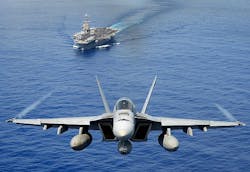Harris advanced targeting systems enable Navy jets to find and attack targets quickly
PATUXENT RIVER NAS, Md., 9 July 2015. Military networking experts at Harris Corp. will provide the U.S. Navy with new airborne targeting systems and situational awareness equipment that enable F/A-18 jet fighter-bomber crews to locate, classify, and attack important targets quickly.
Officials of the Naval Air Systems Command at Patuxent River Naval Air Station, Md., announced a $29.1 million contract last week to the Harris Government Communications Systems Division in Melbourne, Fla., for 138 Distributed Targeting System (DTS) in two separate production lots.
The DTS systems are for Navy F/A-18E/F Super Hornet and EA-18G Growler carrier-based combat jets. Of this order, 126 are for the Navy and 12 are for the government of Australia. The job includes 54 operational bulk data cartridges and parts obsolescence management.
The DTS is a hardware and software system designed to provide precision strike capability against relocatable targets like mobile surface-to-air missile units, Navy officials say.
The system uses sensor imagery gathered from the radar or infrared signatures emitted by potential targets. It then compares those images to references stored within DTS to determine if the target is a threat.
Related: Boeing starts production of F/A-18E/F distributed targeting system
The system is designed to reduce the time it takes to search, identify, classify, pinpoint, and attack a target as well as assess the damage to the target, a process also known as the kill chain.
With onboard communications, one aircraft equipped with DTS can provide several target points to other aircraft. Without this capability, each aircraft derives individual coordinates on each target.
The system is part of the Navy F/A-18E/F Network Centric Warfare Upgrades program and F/A-18E/F flight plan designed to ensure that the Block II Super Hornet will stay ahead of known and emerging threats through 2025.
The DTS was fielded on all Block II F/A-18E/F Super Hornets starting in 2004. Initial operational capability was in late 2012 with operational fielding in 2013. On this contract Harris will do the work in Melbourne, Fla., and should be finished by October 2018.
For more information contact Harris Government Communications Systems online at http://govcomm.harris.com, or Naval Air Systems Command at www.navair.navy.mil.

